#3E-Motivation.
Explore tagged Tumblr posts
Text
#INDUSTRIES#VALUES#TRAITS#3E-Dedication#3E-Empowerment#3E-Accesibility#3E-Equality#3E-Creativity#3E-Achievement#3E-Inclusion#3E-Motivation.#TENSIONS#3E-Inequality of educational opportunities in rural Australia#3E-Stigma attached to higher education in regional areas#3E-Lack of quality education in rural areas#3E-Attrition rates of students in Country Universities Centre#3E-Accessibility of higher education to underprivileged students in outback NSW.
0 notes
Text
So there is a pretty clear shift in playstyle between TSR D&D and WotC D&D: for better and for worse, D&D 3e introduced the idea of encounter balance, de-emphasized mechanics that had previously encouraged the GM to think of the monsters as real living creatures (reaction rolls, morale, etc.), and it had the effect of making D&D a much more combat-focused game. D&D has always been a game that's opinionated about combat, it's basically the most expressive and detailed form of play regardless of edition, but combat in the TSR editions was not exactly zoomed in and tactical. The WotC editions purposefully made combat zoomed in, granular, and tactical.
And this has had an effect on playstyle: since combat is now the main form of player expression what players actually want is for their characters to get into combat. Because combat is the most fun part of the game. But the game has also changed from the largely amoral dungeon-crawling game into a game of fantasy heroics (even though a lot of the trappings of the amoral dungeon-crawling still remain, which contributes to the dissonance), so you can't just have the player characters going into combat for the sake of it. That would frame the player characters as kind of Fucked Up, and we can't have that in our supposedly heroic fantasy.
What you end up with is a variety of contrivances like "they're bandits," "they're cultists," or, my all-time favorite, "they attacked first" to make the action seem morally justifiable, even though gameplay is still motivated by a desire to fight. The monsters fight to the death and, importantly, can often not be reasoned and negotiated with, partly because combat is supposed to be the fun, engaging part everyone is here to do, but also because if they actually acted like reasonable people it could cause dissonance with the whole "the player characters are the goodest heroes."
As my friend @tenleaguesbeneath once called it: what is actually going on is that the player characters are hunting people and monsters who have been programmed to fight to the death and never negotiate for sport, while justifying it as self-defence.
It's a simple power fantasy, and I don't think there's anything wrong with it. Sometimes you want to play a morally uncomplicated game about killing guys with cool magic swords. But I think it's also fun to think about what the specific types of monsters players end up fighting reveals about Society the invisible, unexamined ideology lying under the surface that the designers of even modern D&D have failed to examine. And to me it often reads like a frontier justice fantasy. None of that is to detract from anyone's joy of the game, and for me it's just fun to think about and post about this stuff while Still Enjoying the Game, but if someone expressing that opinion makes you feel uncomfortable, why? That's pretty silly imo.
615 notes
·
View notes
Text

DAYYYY NINEE:
Not a lot when i was little little, but 100% in middle school. Prevalence of Big Back ruined us as a society. 💀💀💀

Tried to start this and lit got t'd the next day... sooo attempt 2?
Day 1: my stats
Sw is like 160-170?
114.7 lbs *current lw too*
Bmï 16.9
#@n@ buddy#@n@ diet#@n@ meal#@n@ blog#@n@ tips#3ating d1sorder#@n@ trigger#@na motivation#mealsp0#3d but not sheeren#3d blog#tw 3d vent#3d f4st#3d not sheeran#!!! <3#3e
14 notes
·
View notes
Note
I come to you on my hands and knees (relevant to the topic right lol) begging for any and all info on Bane, Banites and how it all ties in with Gortash. I love you in advance. <3
Bane and His Cult
Alright, so after twelve and a half hours of research I still don’t fully feel like I have enough, but at a certain point I just need to get this out there, and if there is anything you – or anyone else – would like to see explored in more detail, please feel free to ask!
Note: I love getting asks like this! There is such a vast quantity of Realmslore that having some sort of specific focus for my deep-dives is a huge help, and knowing the topic is of interest to others is a huge motivator. I also greatly enjoy getting to put my training as a historian to work, as there is so much to interpret and archive alike.
As ever, these writeups will align with current 5e lore, and draw from 3.5e for additional supporting information. On rarer occasions – and always noted – I will reference 1e and 2e, but with the caveats that there is much more in those editions that is tonally dissonant with the modern conception of the Forgotten Realms, and thus generally less applicable.

We’ll begin with one of the most recent conclusive descriptions of Bane, from the 5e Sword Coast Adventurer’s Guide, an overview of the current world-state of, well, the Sword Coast:
Bane has a simple ethos: the strong have not just the right but the duty to to rule over the weak. A tyrant who is able to seize power must do so, for not only does the tyrant benefit, but so do those under the tyrant’s rule. When a ruler succumbs to decadence, corruption, or decrepitude, a stronger and more suitable ruler will rise. Bane is vilified in many legends. Throughout history, those who favor him have committed dark deeds in his name, but most people don’t worship Bane out of malice. Bane represents ambition and control, and those who have the former but lack the latter pray to him to give them strength. It is said that Bane favors those who exhibit drive and courage, and that he aids those who seek to become conquerors, carving kingdoms from the wilderness, and bringing order to the lawless.¹
This gives us the briefest summation of what draws people to the Cult of Bane: the desire for power and control, often deriving from a sense that they lack exactly those two things. Bane is the quintessential deity of lawful evil, which – if you’ve read any of my previous posts on the sociology of the Nine Hells – bears a striking similarity to Baator itself, the realm of lawful evil, and the place where Enver Gortash spent at least a portion of his formative years.
The majority of the following excerpts derive from 3e, which went into far more detail on the specificities of the Faerûnian gods, including their dogmas, holy days, et cetera. One important point to note, however: any discussions of Bane’s scope of power are no longer accurate, as the time period in reference is about one hundred and twenty years before Baldur’s Gate 3 is set, at a time when Bane had just returned to life – and godhood – as nothing less than a greater god. By comparison, during Baldur’s Gate 3, he is a quasi-deity, having abandoned most of his previous godly power in exchange for the ability to directly meddle with Faerûn – forbidden to the gods by the overgod Ao – and gambling that he would be able to regain his lost power and prestige in so doing.²
The dogma of Bane – that is, the core tenets and philosophies that his followers seek to emulate – is as follows:
Serve no one but Bane. Fear him always and make others fear him even more than you do. The Black Hand always strikes down those that stand against it in the end. Defy Bane and die — or in death find loyalty to him, for he shall compel it. Submit to the word of Bane as uttered by his ranking clergy, since true power can only be gained through service to him. Spread the dark fear of Bane. It is the doom of those who do not follow him to let power slip through their hands. Those who cross the Black Hand meet their dooms earlier and more harshly than those who worship other deities.³
Even were there nothing else to go off of, this would tell us a great deal about the group dynamics of any followers of Bane, whether established church or fragmented cult. Just as in the Hells, hierarchy is everything to proponents of lawful evil. Any cult of Bane would have a strict order to its power structure, and there would be limited – practically nonexistent – tolerance for any questioning or insubordination of that order. To the minds of Banites, such is simply the natural and superior ordering of the world. These interactions are detailed below:
Within the church, the church hierarchy resolves internal disputes through cold and decisive thoughts, not rash and uncontrolled behavior. Bane’s clerics and worshipers try to assume positions of power in every realm so that they can turn the world over to Bane. They work subtly and patiently to divide the forces of their enemies and elevate themselves and the church’s allies over all others, although they do not fear swift and decisive violent action to help achieve their aims.³
The manner of tyranny that Bane holds to is similarly calculated – he is not interested in mere shows of force, but rather in insidious plots that twist and make use of existing rule of law to legitimize tyranny wherever possible. A social tide operated ostensibly within the laws of the land is far more troublesome to fight back against than a simple army.⁴
As far as specific ritual and day-to-day workings of the cult, some can be evidenced here, in broad strokes:
Bane’s clerics pray for spells at midnight. They have no calendar-based holidays, and rituals are held whenever a senior cleric declares it time. Rites of Bane consist of drumming, chanting, doomful singing, and the sacrifice of intelligent beings, who are humiliated, tortured, and made to show fear before their death by flogging, slashing, or crushing.³
In this sense, rituals seem most likely to be used as a display of power and a test of subservience, leaving lower-ranked members of the cult at the whims of their superiors, expected – as noted previously – to attend to their commands with the same alacrity they would use were Bane himself to speak. The rites themselves are designed to reinforce and glorify the primary aspects of their god’s domain: the tyranny of forcing submission and pain from the weak.
Faiths & Pantheons, published a year after the Campaign Setting supplement, provides a similar description of the rituals of the cult of Bane, along with some intriguing and flavorful additions (noted in bold for ease of comparison):
Their religion recognizes no official holidays, though servants give thanks to the Black Hand before and after major battles or before a particularly important act of subterfuge. Senior clerics often declare holy days at a moment's notice, usually claiming to act upon divine inspiration granted to them in dreams. Rites include drumming, chanting, and the sacrifice of intelligent beings, usually upon an altar of black basalt or obsidian.”⁴
As, in the “present day” of Baldur’s Gate 3, Bane has lost much of his foothold on power and his Faith’s old domains, the specifics of architecture of Banite keeps are no longer quite so relevant. However, in times past, when his Faith worked far more openly and held much greater power, the philosophy of Bane was expressed through the architecture of his churches and strongholds:
Tall, sharp-cornered stone structures featuring towers adorned with large spikes and thin windows, most Banite churches suggest the architecture of fortified keeps or small castles. Thin interior passageways lead from an austere foyer to barrackslike common chambers for the lay clergy, each sparsely decorated with tapestries depicting the symbols of Bane or inscribed with embroidered passages from important religious texts.⁴
The social capital of a Faith – a broad term used to encapsulate all followers of a single deity – is often heavily intertwined with the power of its god, a mutualistic relationship that runs in both directions. More social weight behind the Faith means its god’s name and will is conveyed to more people, some or many of whom might apportion some worship or act in alignment with that god and empower them by so doing. More power for the god means more divine actions that can bolster their own image and the reach of their clergy. At its height in the late 1300s, the Faith of Bane was one of the most prominent and powerful, with comparable might to that of a small kingdom.⁵
Something that is important to bear in mind in a setting such as the Forgotten Realms, not only polytheistic, but an environment where the gods being worshiped are demonstrably existent, is that the followers of evil gods are not likely to be obtrusive with the less savory aspects of their dogma. Not only would that, in the majority of cases, do more harm than good to their deity’s long term goals, in the words of Elminster:
A dead foe is just that: dead, and soon to be replaced by another. An influenced foe, on the other hand, is well on the way to becoming an ally, increasing the sway of the deity.⁶
All of this aligns with what we see of the Cult of Bane and its operation in Baldur’s Gate 3. While it does not have the same sway and might behind it as it did a hundred years before, through manipulation of law and carefully applied pressure – of whatever form most likely to yield the desired results, be it threats, bribery, blackmail, or use of hostages – Gortash has enacted a steel web of delicate, ensnaring tyranny across the entire city.
We can even find present-day expressions of the interactions of the cult members, and find that they hold true to what their forebears experienced, further proof of the consistency of lawful evil. A personal note found on the body of a dead Banite guard at the Steel Watch Foundry calls the Black Gauntlet in charge of the Foundry Lab, Hahns Rives, a “disgrace to the Tyrant Lord”, and notes the writer’s intent to “compile a list of Rives’ shortcomings for the Overseers.”⁷ These shortcomings include:
1. Rives failed to reprimand Polandulus for making jokes about Lord Gortash! 2. Rives missed the morning mass to Bane - twice! 3. Rives didn't punish Gondian Ofran when she missed her gyronetics quota merely because she'd lost a finger that day in the punch press.⁷
We can see evidenced here the constant scheming for position and recognition consistent with this manner of lawful evil hierarchy. Both devils and Banites orient their day-to-day lives around how to prove themselves to their superiors, while also undercutting them at any chance they have to prove their own superiority, with hopes of being raised above them.
This is only reinforced further by another text found within the Steel Watch Foundry, Bane’s Book of Admonitions. Its text is not written out for us, but described as such:
A book of adages and precepts for Banites, providing the basic tenets of worship of the Lord of Tyranny, with suggested prayers for common situations. The heart of the book is Bane's Twelve Admonitions, a dozen rules for proper Banite conduct, with punishments specified for failure to comply. The book opens easily to a page with two of Bane's most popular admonitions, number six, the Reprimand for Leniency, and number seven, the Rebuke for False Compassion.⁸
The most likely scenario is that this book was used by the “Overseers” referenced by the anonymous Banite writing of Rives above. The exact position of the Overseers is not made clear, but from context and knowledge of Banite hierarchy, we can infer that they inhabit a place in the hierarchy above both the guard and Rives himself, and that their role is to ensure all those below them uphold the tenets of Bane at all times, never losing sight of his will.
In that context, it makes sense that they would both have a book of specific punishments for specific infractions – rule of law, after all – and that, given the attempted report on Rives, punishments (“admonitions”) for the crimes of leniency and false compassion – and all compassion is false when your conception of the world does not allow for its existence – would be those most referenced. It would be incredibly important to the unity of the cult, as well as to Gortash’s plans, to harshly punish any observed leniency or break from Bane’s law among members of the cult.
Not only would failure to control the situation at the Foundry potentially spell failure for the schemes of Bane’s Chosen, any unpunished step out of line by members of the cult would be seen as tempting others to do the same, a trickle of dissent quickly becoming a flood. Better to ensure that all adherents live in merited fear of the consequence of failure.
After all, it is said of Bane himself: “He has no tolerance of failure and seldom thinks twice about submitting even a loyal servant to rigorous tortures to ensure complete obedience to his demanding, regimented doctrine.”⁴
And, in an appropriately lawful hierarchy, the same rule must apply from the bottom, to the top.

¹ Sword Coast Adventurer’s Guide. 2014. p. 26.
² Descent into Avernus. 2019. p. 231
³ Forgotten Realms Campaign Setting 3E. 2001. pp. 237-8
⁴ Faiths & Pantheons. 2002. pp. 15-16.
⁵ Forgotten Realms Campaign Setting 3E. 2001. p. 93
⁶ Ed Greenwood Presents: Elminster’s Guide to the Forgotten Realms. 2012. pp. 135-6.
⁷ Rives’ Failures as a Banite. Baldur’s Gate 3. In-Game Text.
⁸ Bane’s Book of Admonitions. Baldur’s Gate 3. In-Game Text.
#voidling speaks#asked and answered#realmslore#meta#my meta#bg3 meta#bg3#bg3 gortash#bg3 bane#enver gortash#bane#baldur's gate 3#forgotten realms#cult of bane#d&d 5e#d&d 3.5
126 notes
·
View notes
Text
It's time for part 2 of my sbk creators in superhero au (Part 1 with Viking and Ruby can be found here)! This time, Avid and Marma1ade are up.
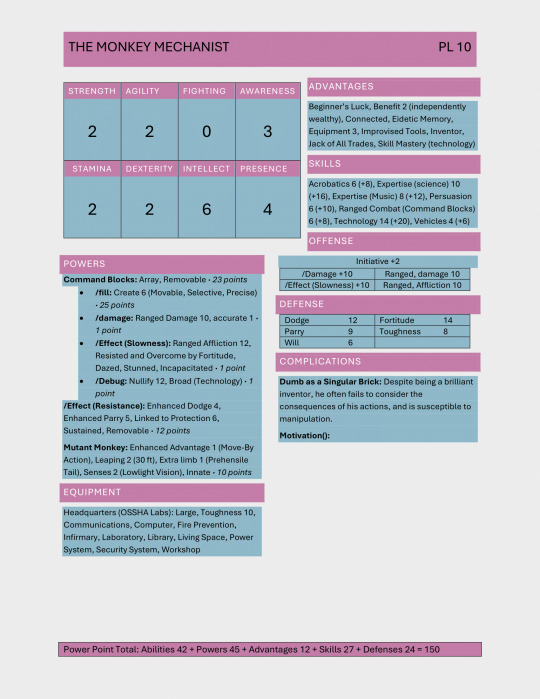
Avid in this au is the Monkey Mechanist - rock star by day, mad scientist by night. I picked the colors from his OSSHA uniform - surely that's not important though :3
Avid here is a masterful inventor; he has the maximum technology bonus that's possible at this power level, and between his improvised tools, inventor, and skill mastery advantages, he can whip something up for just about any problem, and his headquarters at OSSHA labs gives him the space and materials to do it (bonus points for whoever can guess what OSSHA stands for in this au). Though he would probably prefer to avoid combat, he's not helpless. His command blocks, blocks of modular nanotechnology, allow him to create objects, restrain opponents, and shut down other technology. Without them, though, he's extremely vulnerable; his monkey traits don't do much for him in combat.
This is also the first one of these where I have to explain how arrays work. In mutants and masterminds 3e, you have a limited number of points with which to build your character. Arrays are a shortcut built into the system; using an array, you buy a single power at full cost and any number of other powers with the same or less cost as 1-point "alternate effects". This comes with a catch, though: you can only ever use one power within an array at a time. This makes it very good for combat skills, but defensive and utility abilities in an array can be a risk...
Also, most of the time when I build characters in this system, I start with the archetypes and templates within the game and tweak them to fit the character I'm working with. For example, Viking is mostly built off of the Speedster archetype, while Avid is based off of the Gadgeteer archetype. I only bring this up to mention that the ability spread I used from that archetype was called Adventurer :). Also, I didn't build off an archetype for Ruby - I had to build his character from the ground up, which is a little harder but has a lot more flexibility.
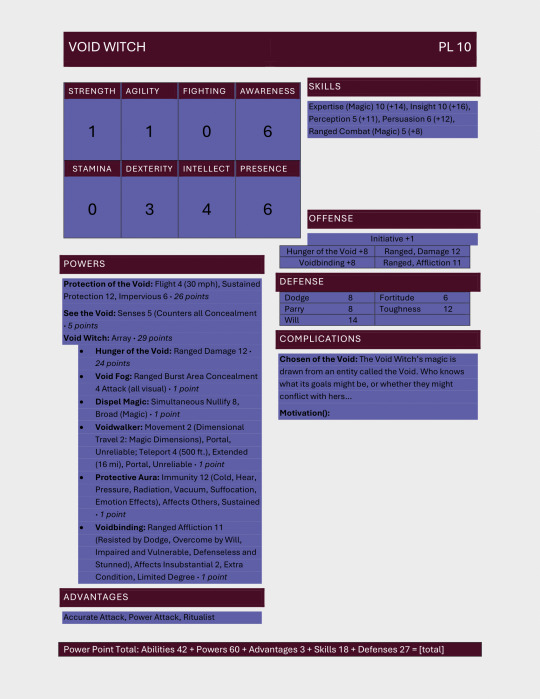
Marmalade's colors are from her dress and her eyes. Her current name is a placeholder - superhero names are hard and superhero names for mages that haven't been used before are practically nonexistent. (if you have ideas please tell me I've been trying to think of a good one since I thought of this au)
Void witch is a good description of her abilities though. Magic drawn from the Void makes her the heaviest hitter by far of the characters I've made, and the accurate attack and power attack advantages give her a lot of flexibility in fights. Most of her magic is in her array, which provides both her offensive options and a few other possibilities - noticeably her protective aura, which allows her to shield herself and others from certain effects, though she can't do much else while she has that active. She also has access to portals for movement both within and between dimensions, but she may not always have that one down; the unreliable modifier means that there's a chance for failure every time she uses it, like, for example, if she was trying to escape a limbo dimension. or something like that. On the defensive, she's very resilient, and her will defense is very good, letting her resist mental effects well.
You may also notice that each character has two complications: one that I filled out, and a blank motivation. Characters in m&m are required to have at least two complications, one of which must be a motivation (you can have more if you want). I decided to intentionally leave the motivation blank, both because I wasn't 100% sure on those and because I wanted to leave some room for speculation/development if I actually write this au.
I've written way more for this post than the last one...hopefully that doesn't become a trend these are already very long. Also I lied a little about how long these take I already had them built when I posted the other ones oops
#skyblock kingdoms#avidmc#marma1ade#sbk#sbk superhero au#<- that one's so I can actually find these later if I come back to them#I swear the marm colors looked good when I was working on them#I am choosing to blame tumblr for this
10 notes
·
View notes
Text
Mind Flayer, Illithid
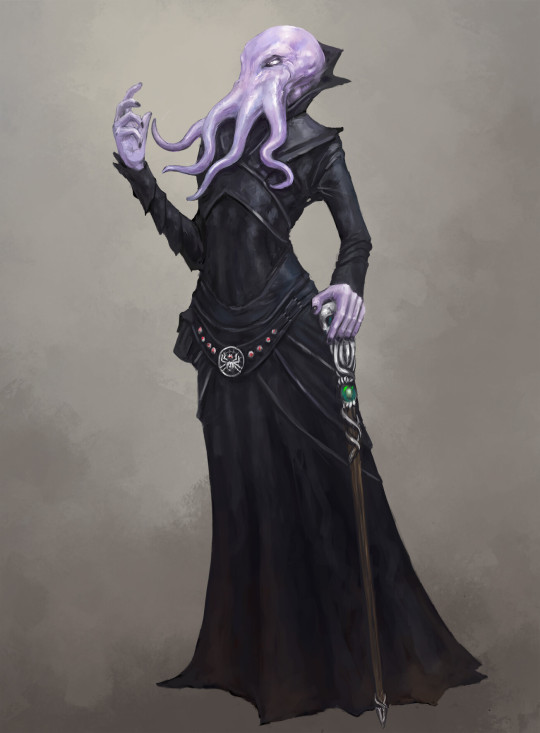
"Mindflayer" © Steven Bellshaw, accessed at his ArtStation here
[In designing a mind flayer, I wanted to avoid some of the pitfalls of the past. The 3.x mind flayer was very fragile, and the mind blast very disruptive, so that fights with them either resulted in the mind flayer getting pulped before it could do anything, or the entire party stunned long enough for the mind flayer to get halfway to a TPK. So I wanted to give them a bit more bulk. 5e gives them full on breastplate, but I wanted to keep the slick leather look from the 3e era. I did take the save every turn and limited uses for the mind blast from 5e. Although I'm not using the psychic magic ability for my mind flayer (because it sacrifices uses/day for versatility), I did use a couple of occult spells so they have some way to deal damage.]
Mind Flayer, Illithid CR 7 LE Aberration This lean humanoid has slick lilac skin and a head like that of an octopus. Multiple tentacles surround a lamprey-like maw. It wears leather robes decorated with skulls and other macabre accessories.
Illithids are the most common and most widespread of the mind flayers. Although some of them live in colonies close to an elder brain, the better to both share its knowledge and fertilize its eggs, many of them live solitary lives or in small communities more similar to a monastic cell. Every illithid desires power and knowledge, and they all go about obtaining these in different ways. Illithids with the same creed may come together in a circle, or illithids of several creeds may travel together in what is called an inquisition, similar to an adventuring party of humanoids. Many illithids keep multiple charmed or dominated slaves to serve them as physical labor and emergency rations.
Most illithids avoid direct physical confrontation if they can help it, instead sending their slaves to the front lines and fighting with their magical abilities. Illithids are masters of mind-influencing magic, and are capable of turning allies against each other or forcing their enemies into hazardous situations. Their most feared ability is the mind blast, which can incapacitate an entire party long enough for the illithid to close in and bore its tentacles into the brains of a victim or two. Illithids usually flee if combat turns against them, as they value their lives above all else.
Illithids are usually tall and imposing, averaging six feet tall but lean. Their skin is usually in shades of pinks and purples, although green and blue hues are not uncommon. They dress in a fashion suggestive of aristocracy—high collars, fancy robes and jewelry are typical. Their unique language, Qualith, is written only and similar to cuneiform; they speak in hissing, rasping tones when they use their mouths, but usually rely on telepathic communication.
Illithid CR 7 XP 3,200 LE Medium aberration (mind flayer) Init +3; Senses darkvision 60 ft., low-light vision, Perception +12 Defense AC 19, touch 13, flat-footed 16 (+3 Dex, +2 armor, +4 shield) hp 68 (8d8+32) Fort +6, Ref +5, Will +9; +4 vs. emotion effects SR 22 Defensive Abilities affectless; Weakness light blindness, sunlight sickness Offense Speed 30 ft. Melee masterwork light mace +10/+5 (1d6+1), tentacles +4 (4d4 plus grab) or tentacles +9 (4d4+1 plus grab) Special Attacks mind blast, pith (tentacles) Spell-like Abilities CL 8th, concentration +12 (+16 casting defensively) Constant—mental barrier I At will—detect thoughts (DC 16), levitate, mind thrust II (DC 16), suggestion (DC 17) 3/day—charm monster (DC 18), dimension door, dominate person (DC 19) 1/day—fly, plane shift (DC 19) Statistics Str 12, Dex 16, Con 18, Int 19, Wis17, Cha 19 Base Atk +6; CMB +9 (+12 grappling); CMD 20 Feats Agile Maneuvers, Combat Casting, Magical Aptitude, Weapon Finesse Skills Bluff +10, Fly +10, Intimidate +13, Knowledge (arcana) +17, Knowledge (dungeoneering, planes) +14, Perception +12, Sense Motive +9, Spellcraft +15, Stealth +12, Use Magic Device +12; Racial Modifiers +4 Knowledge Languages Aklo, Qualith, Undercommon, telepathy 100 ft. Ecology Environment underground Organization solitary, inquisition (2-4), circle (5-12 plus 0-1 ulitharids) or colony (20-200 plus 1 ulitharid per 10 individuals and 1 elder brain) Treasure double standard (masterwork light mace, masterwork leather armor, other treasure) Special Abilities Mind Blast (Su) As a standard action, an illithid can create a 60 foot cone of mental energy. All creatures in the area must succeed a DC 18 Will save or be stunned for 3d4 rounds. A creature that is stunned may attempt to recover from this condition as a full-round action with an additional DC 18 Will save. Mind flayers are immune to the effects of a mind blast. An illithid can use a mind blast three times per day, and must wait 1d4 rounds between uses. This is a mind-influencing effect, and the save DC is Charisma based. Tentacles (Ex) An illithid attacks simultaneously with all its tentacles, treating them as a primary natural weapon.
184 notes
·
View notes
Text
Assassination Classroom Notion Page

So I'm in the process of making a motivational Assassination Classroom page because I rewatched the show like three times this month and I realized just how much of a comforting and motivating space it provides.
Basically it's like motivation for studying and getting through life. I'm not finished but here's the 3E singers sections.

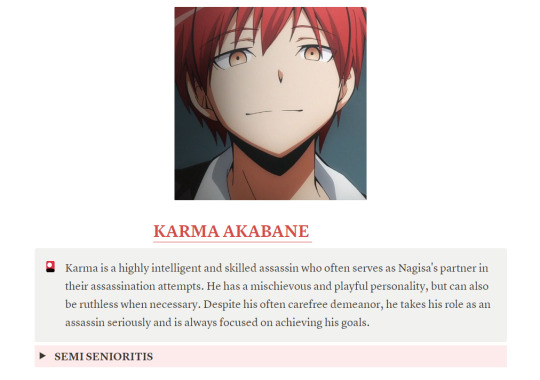
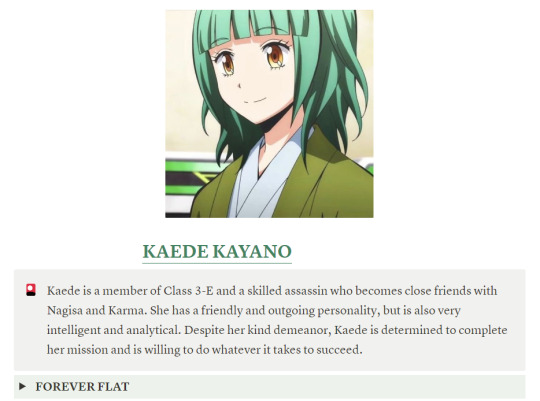

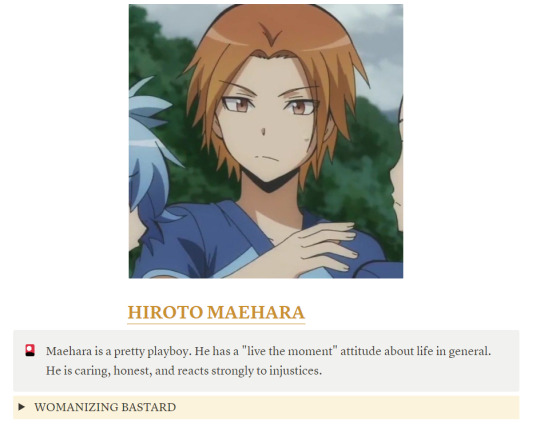
All the checklists are kind of personal. They're specified to my personal goals and what habits I want to build, so if you want to take inspo from this, you can always add things like personal headcannons too!
#assassination classroom#karma akabane#nagisa shiota#kaede kayano#hiroto maehara#isogai yuuma#study motivation#studyblr#assassinationclassroom.studyblr
37 notes
·
View notes
Text
Azalin Reviews: Darklord Ivan Dilisnya
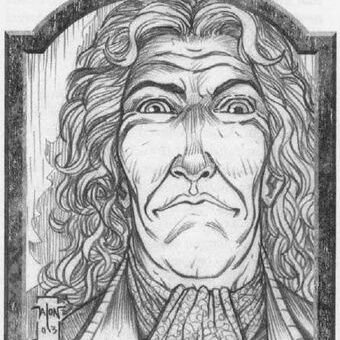
Domain: Dorvinia then Borca Domain Formation: 715 BC Power Level: 💀💀💀⚫⚫ Sources: Secrets of the Dread Realms (3e), Domains of Dread (2e), Realm of Terror (2e), Domains and Denizens (2e), Ravenloft 3e, Ravenloft Gazetteer IV (3e)
Ivan Dilisnya is the Darklord of the former Domain of Dorvinia and now the co-Darklord of Borca with his cousin and aptly named “Dark Twin”, Ivana Boritsi.
Dorvinia was a small region of mountains, evergreen forests, and valleys without any form of formal rule. How it managed to survive for 25 years based largely on the decisions made at the whims of a small, petty man with a love for overacting and toxins is beyond me.
Dorvinia functioned much like how a child would rule a courtroom – bribe the child with the right “toy” and you would find whatever justice they felt like dealing out. Of course, said justice changed from day to day much like a child who enjoys broccoli one day then decides its the absolute worst thing you could put before them the next.
The Dilisnyas’ history in Ravenloft is as old as the first Darklord (but decidedly NOT the first vampire), Strahd. The family was present at the von Zarovich wedding where Strahd thought it was a wonderful idea to murder his brother, then attempt to woo his would-be sister-in-law. We all know how that worked out, but perhaps some of the Dilsinyas had a bit of foresight into these matters, for some claimed illness and left before Strahd’s transformation and murdering of the majority of the wedding guests.
Ivan was born on the same moonless night in December as Ivana. This day is known as the Night of Dead Man’s Get in Borca and every year these cousins celebrate their birthday by inviting everyone to their birthday celebration. Their separate birthday celebrations. It is a way for these jealous, bickering cousins to determine where their subjects loyalties lie. I wonder if anyone has attempted to attend both parties in one evening?
Ivan was cruel at a young age. He enjoyed torturing animals as early as 6 and committed his first murder by 10 by poisoning a young serving girl for the crime of taking a pastry from the kitchen. At 12, with no real motive, he committed matricide by poisoning his own mother in such a way to make it appear that she died of an unknown disease. I, personally, would have named this disease “Ivan”.
Ivan seemed to only show affection towards his elder sister, Kristina. This affection was more akin to obsession than actual love and drove Ivan to acts of violent jealousy. Kristina truly loved her brother and was blind to obvious evil little poisoners ways. Something she would come to regret once she married Edgar Leskovich.
Ivan was the sort that would destroy anyone or anything that stole attention and affection away from him, so Edgar was an obvious threat. The jealousy seethed inside him over the course of their courtship and marriage. Once they had a child, Ivan finally snapped, poisoned them both, adding sororicide to his ledger. The child was saved by their midwife before Ivan could get to them.
Ivan, unable to conceal his crimes from his family, fled into the Mists to avoid their wraith and Dorvinia was formed. A year later he married Lucretia Marzeya. Somehow he managed to go four years without committing uxoricide and Lucretia had three children with Ivan. All of which, he was told, were stillborn. Though, far more likely his wife spirited the children away before Ivan could add filicide to his murder bingo card.
Dorvinia was a short lived Domain, surviving a mere 25 years before it was absorbed by Borca during the Grand Conjunction. Ivan loves to wave his fingers and pout while throwing an overdone and far too dramatically acted temper tantrum and say this is my fault, but he was the one who decided to leave Dorvinia to visit his dear cousin because he was scared of a few tremors.
Ivan now co-rules Borca with Ivana. Ivan never learned how to share, so instead of working with his cousin, Ivan despises her and does all he can to gain favor from the many poisonous peacocks that make up the Borcan nobility.
Ivan surrounds himself with lavish plays, ballrooms, and feasting halls in the Degravo estate, which is well guarded. I suggest never asking Ivan about his “Playroom” unless you want a first hand demonstration of some of his favorite torturing devices.
As a Darklord Ivan is known for his subtle manipulation hidden behind his foppish demeanor, over the top temper tantrums, and, naturally, the ability to poison any object he touches. He is cursed to no longer have a sense of taste. Not to be confused with his love of “acting” and dressing in costumes, this sense of taste is quite literal. Food and drink hold no actual taste to him and turn to ash upon his tongue. This drives him to hold lavish parties where he enjoys serving both delicacies and rotten, maggot covered food. He takes great offense if someone appears to enjoy the food too much or not enough.
One may wonder how such a person manages to maintain loyalty. As Ivan has solved all things in life with poison, it should come as no surprise that he uses poison for this purpose as well. Most of his servants have been poisoned with “Borrowed Time”. These servants will die unless they are administered an elixir, Mercy, each day before sunset.
Ivan continues to age whereas Ivana does not. This leads our jealous, overgrown child to believe Ivana is hiding the secret of mortality and eternal youth from him. Perhaps she is. Who am I to give away such secrets?
Despite his child-like and foppish mannerisms, Ivan should not be underestimated. He holds a powerful position in Borca and can make or break anyone with the wave of his hand. His ability to poison any object has been the downfall to invading armies. Though it was Vlad’s army, so we can’t give him TOO much credit for defeating that failure mercenary. Though, if anyone ever gets a hold of the recipe for Mercy, I feel Ivan would quickly have a rather large uprising to deal with.

Domain: Dorvinia then Borca Domain Formation: 715 BC Power Level: 💀💀⚫⚫⚫ Sources: van Richten's Guide to Ravenloft (5e)
Ivan’s ties to Dorvinia are not mentioned within Dr. Ricky’s new guide, nor is he named Ivana’s Dark Twin, but is referred to as her elder cousin. I’m sure Ivan is very pleased by that development and isn’t throwing a temper tantrum right now as he reads this.
His beginnings are similar to previous accounts, though we a few less “cides” checked off on his frequent murderer club card during his childhood. Instead, it was the Dilisnya’s pets and servants that fell to his murderous ways as his parents covered them up.
Ivan had no desire to grow up. Honestly, I can’t really blame him there. Growing up is very overrated. I can’t remember the last time I felt that naïveté of youth that we so often take for granted. Anyway, I digress…Ivan surrounded himself in fantasy to escape responsibility. He indulged in child-like behaviors and crafted toys and games he forced his sister, Kristina, to play with him. His parents, ever the enablers, allowed this behavior to continue and even set up whimsical rooms and diversions for him throughout their estate.
Being a very stable individual, when he discovered that Kristina was being sent away to a boarding school, Ivan snapped and murdered his entire family in a single evening with his toy creations. Perhaps he wanted to fill up his murder club card before it expired.
As the co-Darklord of Borca, Ivan is a feeble, ancient man who uses a large spider pram to get around. The spider pram carries him throughout his estate, which now mostly resembles a demented child’s playroom full of murderous clockwork toys, animals that would be better off in Markovia, and toy-enacted operas. Well, at least he still retained his curse of having “no taste”.
Ivan is afraid to leave his home, so our Tormentors gifted him with the ability to deliver letters to anyone anywhere he pleases. Ghosting him doesn’t work, so try not to get the attention of this childish stalker or after sending you hundreds of letters he may set forth in his trusty spider pram and greet you in person.
He’s also very good at convincing other’s that he’s a helpless child. Well, they say that the best lies are closest to the truth…
Lastly, he can make any toy he desires. Mostly this amounts to servants and fake versions of the family he killed because he’s a sad and lonely man with only a spider pram to keep him company.
He still retains his hatred of Ivana, though it’s more because she now holds the position he was supposed to inherit. Ivan…you did inherit it. Perhaps spend a little less time writing fan letters to everyone and a little more time investigating this little tidbit.
A childish toy maker in a spider pram makes the creepiest of stalkers, but not an overly powerful one. Although Ivan’s toys are immune to Ivana’s poison, his overall presence and influence over the realm of Borca no longer holds the same force that Ivana holds. Despite the lovely spider pram, this new Ivan does not appear to be as powerful as his predecessor. 2/5 Skulls, mostly for the spider pram.
17 notes
·
View notes
Text
Development Pipeline: How Determined Started [Pt. 1]
This Dev Pipeline is the story of how I decided to abandon a game that I've been developing for three years now.
It starts in the summer of 2021, when I was encountering the Old School Revival movement for the very first time. Why I hadn't heard of the OSR any earlier remains a mysterious accident of history, but in any case, the game's inception was a direct result of reading Matthew Finch's A Quick Primer for Old School Gaming (yes, this is also secretly a Plumbing the Depths post).
In the Primer, Finch presents scenarios to illustrate the differences between "old school" and "modern" (in this case, 3E D&D) play.
In the first, a party is searching for a suspected pit trap. The 3E approach is trivial: one dice roll for a perception check; one roll to disable the trap; situation resolved. By contrast, the OSR version involves no dice at all: the players first ask if they can see a seam in the floor, but are stymied by poor illumination; then they consider pressing the suspected area with a pole, but don't have the tool at hand; finally, they empty a waterskin to see if the water will seep through the hidden seam. When it does, they then describe themselves carefully shimmying along the gap between the seam and the corridor wall (since they can't think of any way to "disable" a pit).
To be sure, stopping every ten feet to perform similar experiments sounds like a tedious nightmare, and evidently OSR-Legolas would be no better at spotting traps than OSR-Pippin – but the example is still inspiring. Diegetic mechanics (bespoke, circumstantial rules that characterize all of the relevant properties of the diegetic situation), allow the players to engage with the situation in a highly immersive manner where their natural intuitions lead to viable solutions. By comparison, the 3E approach reads like automated gambling, unmoored from either player skill or diegetic circumstance.
Then Finch moves on to a second example, in which a player has elected to leap down to make a plunging attack on an unsuspecting goblin below. After the last example, I was expecting a similar divide – a few quick dice rolls for 3E, while the OSR involves the player describing their preparation, timing, or maybe some details of goblin anatomy...
But this time, both cases are fully automatic and random. In the 3E case, the GM doesn't know the rules of the game well enough to make the correct ruling, so instead they make a bad, bullshit ruling that upsets the players. In the OSR case, the GM knows that no rule exists at all, and so jumps straight to making an equally bad, equally bullshit ruling that also upsets the players.
For the life of me, I still can't understand why Finch put in this second example that totally undermines his first one. It makes the OSR look haphazard, inconsistent, and sloppy; lacking any real principles to motivate these design choices. But after reading the Primer, there was one idea I couldn't let go of: what if someone did make the combat example work in the same way as the trap-finding one?
Click here for Part 2
3 notes
·
View notes
Text
Now I shall put some of my favorites of the unfinished art from the 100 Kayano Days challenge. [Rubs hands together]
These are all in order from old to new, from September 2022 to January 2023.

It's a hot day. Karma: "I want cuddles, and I can't cuddle Akari (she'd kill me). So..." Nagisa: "You're too hot." Karma: "I know I am." Nagisa: "YOU KNOW THAT'S NOT WHAT I MEANT!!" Karma: "Cuddle time." Nagisa: "IT'S 31 C!!! AKARI, HELP!!" Akari: "Sorry Nagisa! I have another love to attend to. You're on your own."
(Lol the dialogue is kinda off but I like what I was trying to go for.)
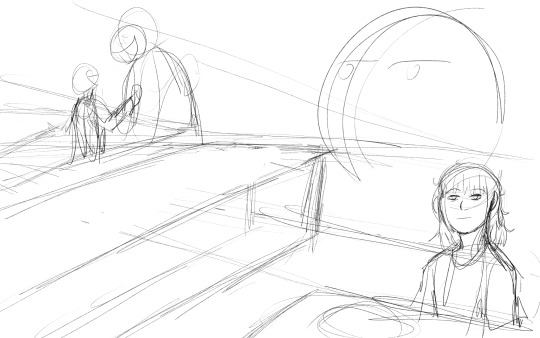
Aguri lives AU but at what cost. Akari is this 🤏 close to losing it.

Adults Kayano, Kanzaki, and Karma went to that one cafe that was doing that collaboration with a popular video game.

GoM AU, with Akari slowly turning into an antimatter creature. It took a long time for her to transform, and there was no cure to stop this. It wasn't fun, but at least her friends were there for her.

Kayano and Akari, Deemo AU, based on that one art for ANiMA from the game.
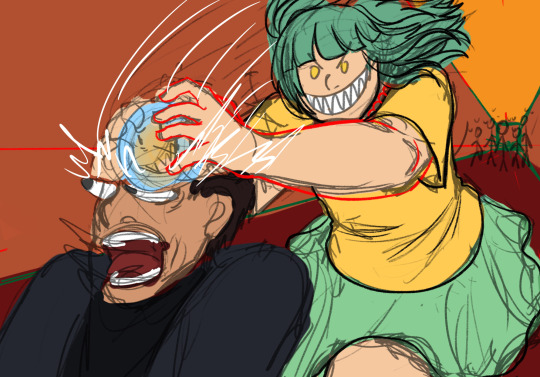
Okay, THIS one I still like a lot. It takes place in the Okinawa arc, and the concept was that there'd be a montage where each student would use Korosensei's Ultimate Defense Form as a blunt weapon to knock out all of the guards. And then end with Karasuma taking out Takaoka the same way.
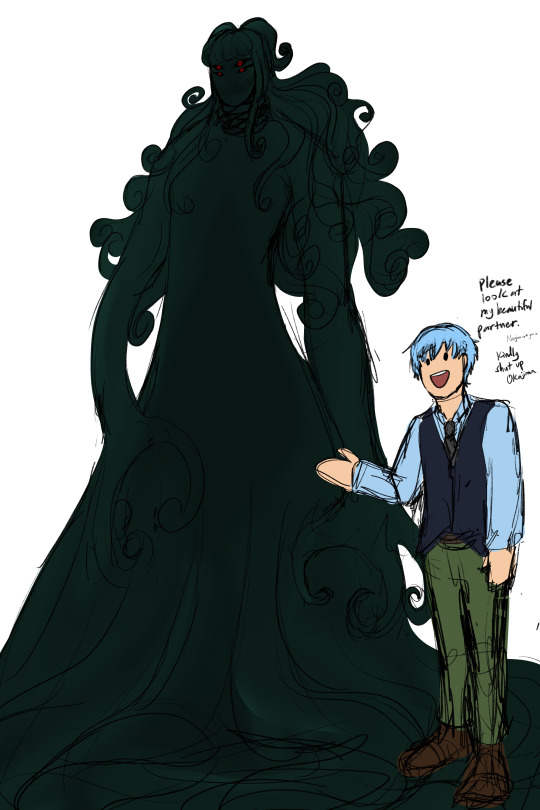
GoM AU again. Nagisa excitedly shows off one of his partners. ...and yes I made antimatter Akari 10 feet tall. :D
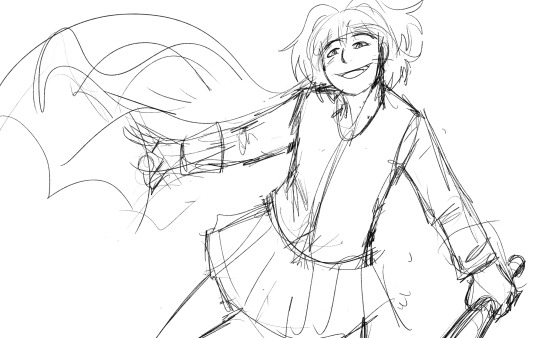

Surprise Koro Q! Based on that one episode from the anime. Imagine if the transformation was permanent.
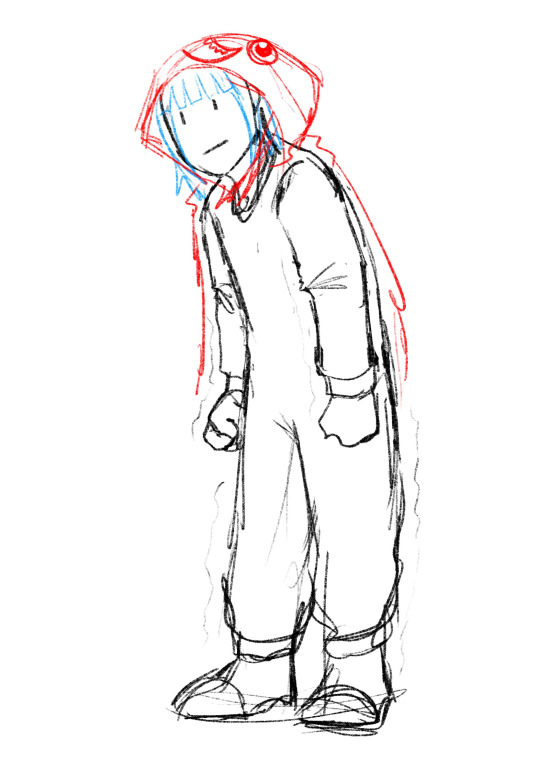
Baby shark doo doo doodoodoodoo...onesie.

Shirt reads: "I am completely normal and not insane I have no desire to harm anyone I am not carrying a weapon." I like the potential chaotic vibes in NagiKae. They're besties.
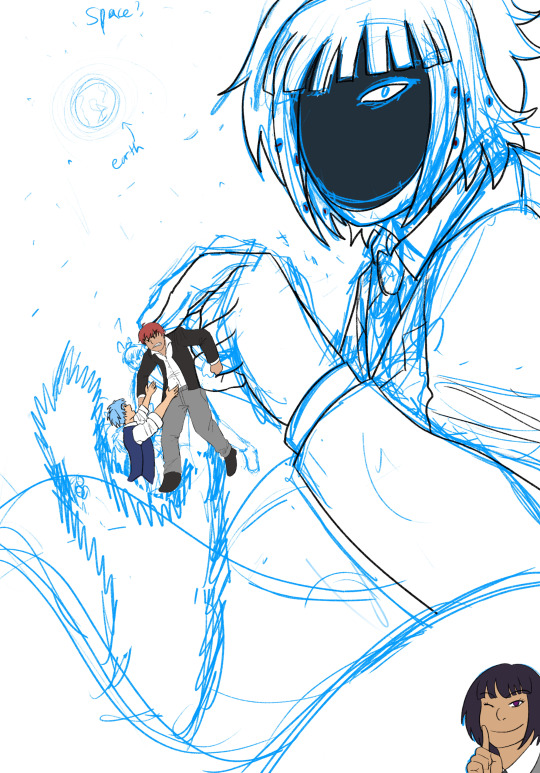

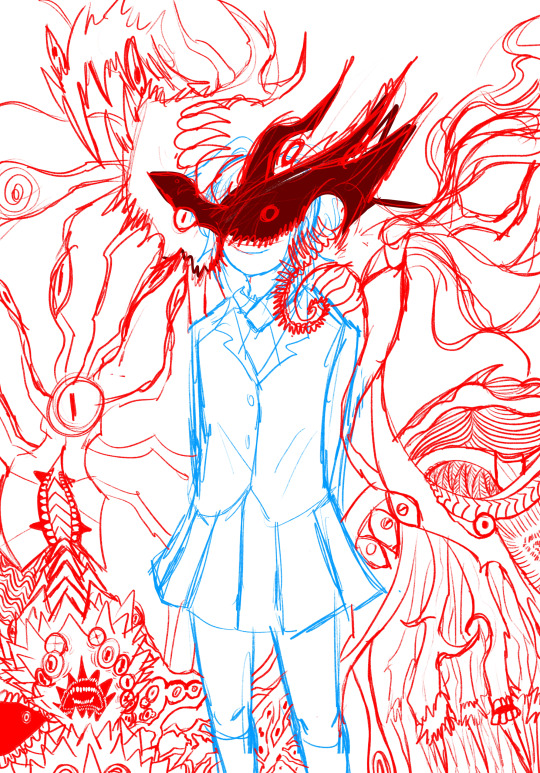
Eldritch AU!!! Context: some of the 3E students are eldritch beings, and Kayano is the reincarnation of an ancient being that ruled a whole other dimension filled with other eldritch monstrosities, which she can summon. This AU gave me so many brain worms, yet not enough to help me finish any of them. 😩
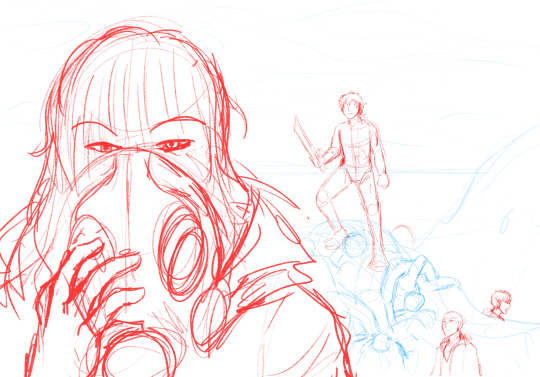
I have a bleak zombie apocalypse AU. Takes place after their high school graduation, probably after the events of Korotan D? Kayano's half-infected, Nagisa's a zombie, Karma has severe head trauma that he can't fix and it's making him go wack, and Gakushuu's trying to keep everything together.
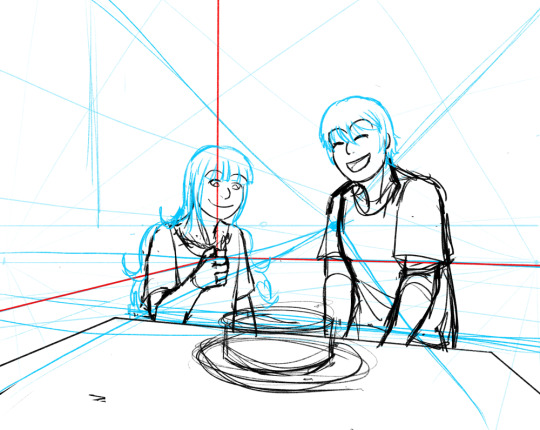
I wanted to draw more than one birthday art for Akari and this was one of them. Just her and her big sister...

This one was gonna be a prank. Forgot about it though LOL.

The concept was Kayano arriving in limbo, dazed, after getting killed. But Aguri tells her to go back. It's not time yet.

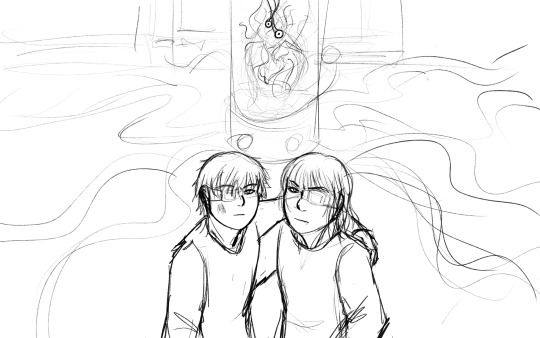
Aberration AU. Takes place 4 years after canon, right around the time they're in college. The monster behind them is basically both of them. Their memories and DNAs make up the monster. Kayano and Nagisa are unhealthily codependent after being kidnapped and used as experiments for...3 years. 😐 But it's okay. They eventually get rescued and get therapy.

Kayano twins AU. I was gonna draw a short comic about the twins but I had to give up because I was struggling for some reason. (Why is this pic so LONG???)

One of the Christmas/Karma birthday ideas. It'd have Karushuu kissing under a mistletoe. Kayano's just here for the desserts, man.
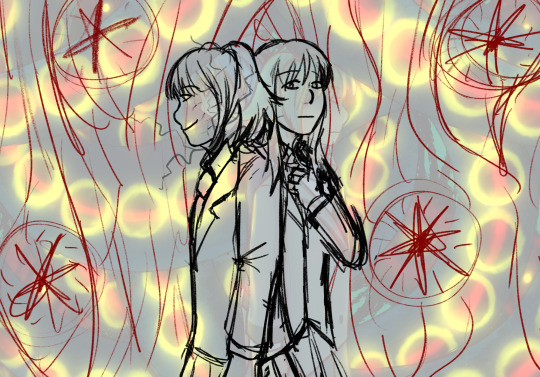
Eldritch AU. This would be a sequel to Day 88, featuring Kanzaki (she's a time god) instead, but I didn't have enough motivation to finish it.
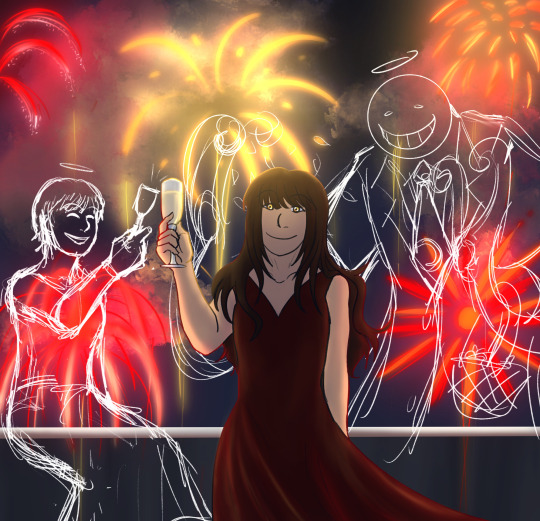
This is just Day 93, but Aguri and Korosensei were supposed to be there with her, along with the rest of group 4!! But I ran out of time.

And finally, this is another limbo situation where the Yukimura sisters would hug each other one last time. But then I thought it was too sad and went for the "Aguri lives" ones.
If you made it all the way to the end, then WOW thanks for reading!! Hope y'all liked reading about my thoughts! There are actually more arts that are unfinished but those are like...really messy lol.
#naem draws#body horror#100kayanokaedays#kaede kayano#akari yukimura#rgb trio#assassination classroom#long post#gom au#gift of metamorphosis#zombie apocalypse au#eldritch au#aberration au#kayano twins au#deemo au#I had to give up drawing most of these because I kept running out of time or didn't have energy to finish haha oops#maybe I can finish these one day...#btw did anyone count all the amongus in the challenge? lol I kinda forgot about it#tba#ask to tag
8 notes
·
View notes
Text
#INDUSTRIES#3E-Productivity#3E-Workculture#VALUES#TRAITS#TENSIONS#3E-generational divides#3E-workplace etiquette#3E-cost effectiveness#3E-employee motivation#3E-employee entitlements.
0 notes
Note
ik nothing abt assclass but please elaborate on your au if you would like to👁️👁️
OK YES OFC!!!!! Sorry for late response I was waiting until school got out lol
Ok so the premise of assassination classroom is as follows: kunugigaoka junior high is a private college prep school notorious for having an extremely hard curriculum and extremely smart students. It is a school of the elite minded, and all the students are faced with an aggressive pressure to excel. The school has a class for third years called 3-E, dubbed the “End Class”. If your grades drop too far, or you show behavioral problems, or disobey school protocol even, you will be shipped off to this class, which is located in the old rickety school building up a mountain and surrounded by forest, just off the main campus. These children can’t participate in extracurriculars, are given no facilities or accommodations, and are faced with intense discrimination and bullying from other students and teachers. They are used as a threat to keep the other students motivation high. You don’t want to end up in E class. And then one year, the moon explodes. The next day, class 3E’s teacher is gone, and replaced with a giant yellow octopus. This is korosensei, the being who blew up the moon, and can travel at Mach 20 speed, can regenerate limbs, and has plans to blow up the earth in exactly a year. His one request was to the teacher of this class for unknown reasons. The government allowed this, since they would then have tabs on him for most of every weekday. They want to kill him before his deadline, and so they tell the kids that since they’ll be around him every day until then, they will be tasked with the job of killing him. However, his teaching and the assassination motivation gives these kids hope and they actually begin to grow and progress. He genuinely cares about these kids and is an amazing teacher. With help from government agent tadaomi karasuma and assassin irina jelavic (aka professor bitch), these kids attempt to assassinate their teacher all while balancing their hellish school life and trying to overcome hardships.
My au is about toya if he were in this class. He is just beginning his rebellion against his father, and is just learning how to navigate it. He begins to do whatever he can to defy his father, and so he purposefully starts failing classes to distance himself from the image of what his father wants him to be. A lot of his personal development comes from realizing that he is his own person, and he doesn’t have to sacrifice things that he loves or that is a part of him just because it’s related to his father.
Also I am going with that white hair from stress hc I saw awhile ago because I LOVE it, so as the year goes on his hair lightens a lot until it’s almost at the point it is in canon by the end of the year. And also. Toya is interesting. Especially in middle school and as a child. I think his time with tsukasa and saki is very formative to him, and he really internalizes a lot of what tsukasa says since he idolizes him so much. He’s very… pure of heart for lack of better term. He believes at first that they can convince korosensei not to blow up the earth by showing him love and friendship, and is almost optimistic in a lot of ways. He clashes a lot with the more realistic and pessimistic members of the class due to this. Also, at one point the class learns parkour to aid in their assassinations, and I like imagining toya because of his fear of heights lol. I think he’d be really good with both knives and guns, but is a sucky sniper because he gets scared when he’s up on the perches. He has relatively weak bloodlust, at least when compared to someone like karma or nagisa, but he’s very talented at channeling what he does have. He can think of spectacularly creative assassination plots but a lot of them aren’t very… realistic and thus are near impossible to pull off. He’s one of the smartest in the class, but stays as one of the lowest ranked for a very long time until he finally decides to put his father behind him and not let him ruin his future like that.
I have. A lot more thoughts but they’re kind of everywhere and hard to explain without the context of the show lol
11 notes
·
View notes
Text
Man @my-smial I don't want to make that post any longer for the sake of OP's notes and our dashboards but the priorities of the 5E DMG are genuinely so baffling to me.
It's like they think the purpose of the DMG is not to, y'know, G the DM, but rather to provide enough tables that you can randomly generate an entire campaign.
except magic items those are too important for random gen.
Like here is the "magic item prices" table:

Doesn't even provide a randomness method (though there is a bit on this in the "selling magic items" section, which is under "downtime").
And here is the table for randomly generating the tactics used by a campaign villain:

(in case the prospect of making literally any decisions about the main feature of your campaign is scary, there's also tables for their motivation, identity, possible weakness, etc.)
There's 4 different d100 tables for determining various quirks of a major artifact in case you include one in your campaign, but virtually no information on... why and how you would do that.
Relatedly, here's the example dungeon map they provide:

If you look carefully, you'll notice that there's.... there's no key.
Even "Appendix C: Maps" doesn't contain a single example of a keyed map. Nowhere in the DMG do they mention "hey you can keep track of dungeon rooms by numbering them."
I don't know if this is a deliberate choice? A really wierd oversight? An example of the "experts in anything etc etc" principle?
Meanwhile, here's the equivalent example from the 3E DMG (3.0, specifically):

It's a fully keyed map, and the accompanying example of play instructs you on how to use map keys, descriptions, common abbreviations like boxed text and stat blocks, etc... as well as literally transcribing what a group playing this dungeon might sound like as they go through a few of the rooms.
The 3E DMG really emphasizes running dungeons over any other aspect of play, but at least it... shows you how to do that. The 5E DMG seems to assume that you've already learned to GM from somewhere else. It gives you lots of tools for building an adventure, but almost nothing on running one.
Several people in the notes of that post have mentioned that their advice for learning to DM 5E is to read the 4E DMG! I haven't spent much time with 4E so I can't speak to that specifically.* Nevertheless, I have to agree that the 5E DMG doesn't really feel like a necessary part of the book trio, and I wouldn't really feel like the teaching it does provide is worth the price tag.
*though from my understanding, encounter balancing and understanding the combat roles of various enemy types is one of 4E's strengths, and that's definitely a useful thing for a DM to get explicit advice on.
This doesn't really affect us since we don't play 5E often anyways, but. Rant written.
3 notes
·
View notes
Text
Finale | 16 septembre 2023
Souvenirs décousus d’une game de balle (Finale RMR 2023, An Oral History)
par Les Martres

M. Raymond Je suis arrivé arrivé au terrain grâce à un lift d'Arthur Raymond, qui était quand même pas pire hangover. Cette année, c’était juste de sa faute à lui.
J. Bourgon Arthur Raymond est arrivé au terrain avec une bunch de bananes et s’est lavé le visage et les avant-bras aux Wet Ones.
A. Fontaine Rousseau C’est vrai que l’affaire des Wet Ones, c’était une drôle de vibe pour commencer la journée. Moi, je suis arrivé crinqué ben raide parce que j’avais écouté du Viagra Boys pis du Turbonegro ben fort à la maison pis là y’a un dude un peu blême qui s’frotte le corps avec des Wet Ones dans les estrades ? Pas la vibe à laquelle je m’attendais.
C. Charland Les vapeurs de Wet Ones m’ont fait tout oublier du match…
A. Fontaine Rousseau Je tiens à préciser que malgré l’affaire du dude qui se tartine avec des Wet Ones, j’ai probablement commencé la game avec ma plus belle claque de la saison. J’pense que c’était un signe.
M. Raymond Au deuxième but, après un solide coup sûr, Mayo s’est fait dire par Jules de se tenir prêt parce que celui-ci allait claquer un ballon-sacrifice pour le faire avancer. Le problème c’est que la définition de ballon-sacrifice était visiblement pas la même pour tout le monde. Mayo a surtout compris cours sur toute et s’est fait retirer comme un enfant d’école.
R. Thibodeau En fait, Jules a parlé en code plus subtil : « Mayo ! Ballon-sacrifice. OK ? » Je lui ai dit, à Jules : « Dis-lui pas ça, ça va le mélanger. » Et la suite me donna raison, lors d’un classique et chaotique REEEEEEVIENNNNNNS !
J. Bourgon Collision au 1er but quand Manu rentre dans Julie (ou Julie rentre dans Manu). Commotion cérébrale refoulée. Manu se sentait mal. Julie était en tabarnac. Mais ils ont fait la paix.

R. Thibodeau Il veut bien se donner une image de brute, ce Ruiz, mais au fond c’est un cœur tendre.
J. Bourgon Jules ben trop excité de porter l’hélice et qui la sort trop tôt (d’habitude Bouchard la sort dans un moment iconique à la 6 ou 7e manche), mais qui fait quand même son move de pogner la balle nu main.
R. Thibodeau Après une 6e manche où on n’a pas réussi un retrait et où les Ninas s’amusaient comme des futurs gagnants, on est revenu au banc un peu débiné... Notre dernier tour au bâton, 7 points en arrière. C’est alors que je me suis rappelé la fois de. Vous rappelez-vous, la fois ? J’ÉTAIS EN RANDONNÉE au pied d’une énorme montagne. Le sommet, perdu dans la brume, me paraissait inaccessible. L'ascension, impossible. Puis, une petite voix m’a soufflé : cherche le réflecteur. C’était la voix d’une petite martre ! Elle me parlait du petit réflecteur cloué sur les arbres pour baliser les sentiers. Je l’ai écoutée, puis une fois au premier réflecteur, j’ai vu le 2e. Puis le 3e… Puis… LE SOMMET ! Un seul coup sûr. C’était ça notre réflecteur. Charland l’a trouvé vite en tabarouette. Puis un 2e, puis un 3e. Puis… LE SOMMET ! C’était fou, car je n’avais même pas pensé à l’histoire de la randonnée comme une métaphore de la partie de balle molle. Je voulais juste parler de ma randonnée, mais ça a semblé motiver les Martres et ébranler les Ninas. La vie est bien faite, quand même.
A. Fontaine Rousseau Vous souvenez-vous de la fois où on a fait une remontée folle en septième manche ?
C. Charland Toujours du mal à m’en rappeler…
M. Raymond J’arrive pas à mieux décrire Poulin en 7e manche qu’avec cette image :

J. Bourgon Maxime a demandé à Christophe s’il se rappelait de la fois. Christophe comprenait rien. Maxime lui a rappelé l’histoire de la fois où on a gagné la finale.
Tout le monde s’est dit au revoir en pensant réellement qu’il y aurait une activité parascolaire aux quilles cet hiver.
C. Charland J’essaie de me rappeler, mais je me rappelle toujours pas de la fois.
R. Thibodeau C’est vrai, les quilles ! Quelqu’un a dit à Brouard qu’il allait s’en occuper, mais elle ne se souvenait plus qui. Peux-tu te manifester, SVP, organisateur.trice des quilles ?
J. Bourgon Julie et Mayo ont encore closé le parté.
Jules a partagé ses moments kinky avec le trophée (et ses grands bas mauves). La victoire de l’année prochaine risque de goûter un peu la graine.
Bouchard a essayé de nous faire croire qu’il a du coeur parce qu’il a porté le chandail des Martres pour jouer une autre finale que la nôtre.
R. Thibodeau Je me demande si Bouchard leur a fait le coup de la casquette à hélice, à son autre finale. Pour me consoler de son absence, j’aime me dire qu’il ne garde ça que pour la RMR.
J. Bourgon Dans tous les cas, les Martres ont démontré qu’elles peuvent gagner même sans hélice !
R. Thibodeau Après la partie, les Ninas ont souligné le fait que cette défaite-là, elle était dure à avaler. Je les comprends. Si j’étais eux, j’oublierais vite cette défaite pour me rappeler plutôt celle de l’an passé, dans cette finale dont on se rappellera comme “l’affaire Cousineau”. Ou même celle d’il y a deux ans, qui s’est finie à peu près 34-2 pour les Martres. Elles étaient un peu moins pires, ces défaites, c’est vrai ! Mais l’an prochain, c’est votre année, les Ninas ! On croit sincèrement en vous, et on vous souhaite de vous refaire des forces pendant la saison froide. Froide, comme la douche que vous avez prise après la partie, diront les langues sales. Mais on n’irait jamais là. Merci pour le bel été à tous ! Ninas 🖤, Martres 💚, RMR ⚾


* * *
LES LAURÉAT.ES DU GALA 2023 DE LA RMR
1. L'AMÉLIORÉ.E Celui ou celle s'étant le plus amélioré.e le temps d'une saison, d'une partie, d'une manche, ou même d'une sortie à l'abreuvoir. Lauréate : TANTAWI Mentions : C. Raymond et M. Raymond
2. MEILLEUR ESPRIT SPORTIF Debout sur le banc, cette personne est toujours là pour aider et encourager son prochain, dans les beaux jeux comme dans les erreurs les plusses pires. Lauréat : THIBODEAU Mentions : Poulin et Hill
3. MEILLEUR ESPRIT DE BAVEUX Cette personne très gripette que tu adores détester et qui sait comment jouer dans la tête de l'autre équipe. Lauréat : RUIZ Mentions : E. Talbi et M. Raymond
4. LA PLUME D'ANGE Auteur.trice du meilleur résumé de la saison. Lauréats : M. RAYMOND et FONTAINE ROUSSEAU
5. LE PORTE-PAROLE DE LA RMR L'orateur ou oratrice par excellence de la ligue, qui donnerait les entrevues les plus divertissantes à RDS et TVA sports. Lauréat : HILL Mention : Berthiaume
6. MEILLEUR MANIEMENT DU BÂTON (FEMME) Celle dont tu redoutes la frappe. Surtout après la réalité du soleil. Lauréate : COUSINEAU Mention : Brouard
7. MEILLEUR MANIEMENT DU BÂTON (HOMME) Celui dont tu redoutes la frappe. Surtout après la réalité du soleil. Lauréat : BOUCHARD Mention : Charland
8. LA MAIN DE FER DANS UN GANT DE BASEBALL (FEMME) Celle qui attrape toutes tes balles sans scrupule. Lauréate : BOURGON Mention : Cousineau
9. LA MAIN DE FER DANS UN GANT DE BASEBALL (HOMME) Celui qui attrape toutes tes balles sans scrupule. Lauréats : RUIZ et GAULIARD Mention : Bouchard
2 notes
·
View notes
Note
Hi!
I'm so glad i found your blog, your deep dives are making my brain tingle in the best of ways! It's so difficult to really find all the info your curious about with the many different editions and histories of everything so you are an absolute lifesaver for understanding all these intruiging lore aspects.
I've been very curious about Asmodeus for a while now but am kinda struggling finding out more about him, I know he's very strong and apparently a large snake?? But I was wondering if you at some point feel the motivation to if you could tell me some about him, he seems so interesting to me and I just wanna know more about who and what he is.
Again, you are so awesome and I vow to devour all your writing!
Asmodeus: An Origin
Thank you so much for the kind words - and for your patience as I worked on this one. If there's any question you had about him that feels like it's not wholly answered here, feel free to let me know! There's still a lot that I was not able to include.
As ever, these writeups will align with current 5e lore, and draw from 3.5e for additional supporting information. On rarer occasions – and always noted – I will reference 1e and 2e, but with the caveats that there is much more in those editions that is tonally dissonant with the modern conception of the Forgotten Realms, and thus generally less applicable.

You would be hard-pressed to find a more succinct introduction to Asmodeus himself than in the following passage, from 3e’s Book of Vile Darkness:
Asmodeus the Archfiend, the overlord of all the dukes of hell, commands all devilkind and reigns as the undisputed master of the Nine Hells. Even the deities that call that plane home pay Asmodeus a great deal of respect.¹
As to his current position, 5e’s Sword Coast Adventurer’s Guide features Asmodeus among the list of gods, naming him the “god of indulgence”, and crediting to him the domains of knowledge and trickery. His symbol is “three inverted triangles arranged in a long triangle”, as seen in the image below.²

While his active circle of worshippers remains small, he is one of the gods habitually turned to by those in need, particularly those who have done something to earn them the displeasure of another god:
After transgressing against a god in some way, a person prays to Asmodeus for something to provide respite during the long wait. Asmodeus is known to grant people what they wish, and thus people pray for all the delights and distractions they desire most from life. Those who transgress in great ways often ask Asmodeus to hide their sins from the gods, and priests say that he will do so, but with a price after death.³
Asmodeus is particularly appealing to those who fear what awaits them after death, or have arrived to find the reality does not match their hopes. For these souls, even the hazards of Baator might be preferable to long centuries of solitary wandering on the Fugue Plane.
All souls wait on the Fugue Plane for a deity's pleasure, which determines where a soul will spend the rest of eternity. Those who lived their lives most in keeping with a deity's outlook are taken first. Others, who have transgressed in the eyes of their favored god or have not followed any particular ethos, might wait centuries before Kelemvor judges where they go. People who fear such a fate can pray to Asmodeus, his priests say, and in return a devil will grant a waiting soul some comfort.³
The worship of Asmodeus attracts staunch individualists, who desire a future unaligned with the domain of any of the other gods, and are willing to choose self-determination in any form that might approach them.
The faithful of Asmodeus acknowledge that devils offer their worshipers a path that's not for everyone — just as eternally basking in the light of Lathander or endlessly swinging a hammer in the mines of Moradin might not be for everyone. Those who serve Asmodeus in life hope to be summoned out of the moaning masses of the Fugue Plane after death. They yearn for the chance to master their own fates, with all of eternity to achieve their goals.³
Asmodeus achieved his current official status of godhood during the Spellplague, which lasted from 1385 to 1395 DR. After this, for reasons he has unsurprisingly chosen not to reveal, he performed a ritual to alter the metaphysical categorization of all existing tieflings, giving them features that highlighted this connection.
Due to this shift, tieflings are often perceived with wariness by those who believe that Asmodeus is able to exert control over these newly-determined “descendants” of his. While this is an unwarranted suspicion, as tieflings are no more bound to his will than any other individual of another race, the mistrust remains unfortunately pervasive.⁴
The true origins of Asmodeus, particularly from 3rd Edition on, are kept rather ambiguous, seemingly quite by design. This is both for Watsonian reasons – that a supreme being of evil such as Asmodeus would not carelessly leave information about his origins (and, potentially, weaknesses) floating around – as well as Doylist: it is a more elegant solution than eternal retcons, and leaves it up to the individual scholar or DM which explanation they ascribe the most veracity to.⁵
On the charge of Asmodeus’s true form being a giant serpent, we have Chris Pramas to thank for that bit of lore, stated in 2e’s 1999 Guide to Hell, but rarely mentioned - and not in any definitive manner - from 3e onward.⁶ 3e’s Manual of the Planes, published in 2001, does reference this account, but as a whispered and shadowy theory about the Archdevil Supreme, rather than objective truth.
Brutally repressed rumors suggest that there is more to Asmodeus than he admits. The story goes that the true form of Asmodeus actually resides in the deepest rift of Nessus called the Serpent’s Coil. The shape seen by all the other devils of the Nine Hells in the fortress of Malsheem is actually a highly advanced use of the project image spell or an avatar of some sort. ... From where fell Asmodeus? Was he once a greater deity cast down from Elysium or Celestia, or is he older yet, as the rumor hints? Perhaps he represents some fundamental entity whose mere existence pulls the multiverse into its current configuration. Nobody who tells the story of Asmodeus’s “true” form lives more than 24 hours after repeating it aloud. But dusty scrolls in hard-to-reach libraries (such as Demogorgon’s citadel in the Abyss) yet record this knowledge. Unless it is pure fancy, of course.⁷
One can see from the framing of the above excerpt that there is no attempt made at certainty. Perhaps it is mere conjecture, or perhaps a secret, hidden truth that few may know. It is impossible to say for certain.
Another story of Asmodeus’s possible origin is found in 3e’s Fiendish Codex II. This text, again, does not frame the information given as universal truth, but rather takes pains to emphasize its ambiguity.
The best way to understand devils and their ways is to listen to the stories they tell about themselves. The most famous of these tales have propagated as myths throughout all the worlds of the Material Plane, becoming familiar to mortals of all sorts. But as is often the case with legends, contradictions abound. For example, the tale of the Pact Primeval is the accepted version of the multiverse’s creation. But an alternate story claims Asmodeus as the fallen creator of the universe. Countless cultures have their own versions of the Pact Primeval legend. The names of the deities featured in it change depending on where it is told, but the names of the devils are always the same. Perhaps this fact is what inspired Philogestes, the accursed philosopher of evil, to pen his famous proverb: “The gods exist in multiplicity, but Asmodeus is unique.” As is the case with any myth worthy of the name, the following tale is true — whether or not it actually happened.⁸
In this account, Asmodeus began as a celestial embodiment of law, formed from the concept itself to fight against the embodiment of chaos — demons.⁹ Over time, as he and his followers became more akin to the enemies they were facing, those celestial beings not engaged in the fight grew leery of what they were becoming, and took him to trial, to account for himself. The god of valor spoke first, laying out the concerns of those gathered against Asmodeus. In response:
Asmodeus smiled, and the smoke of a thousand battlefields rose from his lips. “As Lord of Battle,” he pointed out, “you should know better than any that war is a dirty business. We have blackened ourselves so that you can remain golden. We have upheld the laws, not broken them. Therefore, you may not cast us out.”⁸
Despite their efforts, the gods were able to find no laws that Asmodeus had broken. Unsurprisingly, as he himself had helped write them. This conflict between Asmodeus and his host and the remainder of the unsullied gods continued on, with the gods unable to get rid of him, and free themselves of the constant reminder of the Blood War.
With time, the concepts of “good” and “evil” entered the world alongside law and chaos, and Asmodeus was able to argue for dominion over those souls that chose evil. The gods loathed the reminders of this fact, however, and when Asmodeus volunteered to move to the empty plain of Baator, they enthusiastically agreed. It was only years later, when the number of souls arriving at their own planes after death began to sharply decrease, that they thought to travel to Baator themselves, where they found a robust operation based around encouraging mortal souls to take to the path of evil.
“You have granted us the power to harvest souls,” replied Asmodeus. “To build our Hell and gird our might for the task set before us, we naturally had to find ways to improve our yield.” The war deity drew forth his longsword of crackling lightning. “It is your job to punish transgressions, not to encourage them!” he cried. Asmodeus smiled, and a venomous moth flew out from between his sharpened teeth. “Read the fine print,” he replied.⁸
While the recorded story implies a simple act of one-upmanship, a later section of the Fiendish Codex tells us that Asmodeus’s split from the other celestial deities was not so amicable.
Once he had committed himself to residing in Baator, the deities physically cast him out of the upper realms, and he fell — and fell, and fell. Upon reaching the plain of Baator, he plunged through the nascent layers he had begun to shape. (In some versions, his fall created the layers, breaking the formerly featureless plain into nine pieces, which then arranged themselves into floating tiers.) At last he hit solid ground but continued to fall, spiraling through rock and soil. The protesting earth of Baator tore at his flesh, opening scores of gaping wounds. Still he fell, until he could fall no farther. The point where he finally stopped was the deepest part of Baator — the Pit. The wounds that Asmodeus suffered in his dramatic fall have never healed. Though he manages to appear blithely unperturbed by his injuries, they still weep blood every day, and he has been wracked by constant pain for millennia.¹⁰
This casting down and its associated injuries is corroborated in other texts as well, including 3e’s Manual of the Planes.
5e’s Mordenkainen’s Tome of Foes seemingly follows on from the Fiendish Codex’s account, sharing one conception of the fallout of Asmodeus’s stratagem, positioned as an in-universe account penned by the aasimar bard Anodius in a work titled “The Trial of Asmodeus”.
At some point after Asmodeus broke from Celestia to rule Baator, he was brought up on trial for unspecified crimes and trespasses. Asmodeus claimed the right to speak in his own defense, and a court was gathered, arbitrated by Primus, a being intrinsically aligned with Neutrality and Law. From Asmodeus’s recorded arguments in his own defense, we can surmise that those on Celestia had accused him of acting outside of the law in actively working to turn mortals to evil.
The case stretched on, with neither side ceding ground, for weeks, until finally Primus declared his judgment. While Asmodeus could not be convicted of any true crime – for he had acted within the law in all things – he was to take an artifact, the Ruby Rod that is synonymous with his position, which would “guarantee his adherence to law”.¹¹ A quote from Anodius’s in-universe text is helpfully provided by Mordenkainen:
“I literally sit beneath eight tiers of scheming, ambitious entities that represent primal law suffused with evil. The path from this realm leads to an infinite pit of chaos and evil. Now, tell me again how you and your ilk are the victims in this eternal struggle.” – Asmodeus addresses the celestial jury, from The Trial of Asmodeus¹¹
In a manner similar to his contested origin, Asmodeus’s appearance is described in several varying ways — a fact that seems in line for a principal schemer such as himself. This seeming discrepancy could also speak to varying uses of aspects or projection spells.
The Fiendish Codex II in one instance paints him as “a horned, red-skinned humanoid with a tall, lithe frame” who “dresses in splendid robes and understated but elegant accoutrements.”¹⁰ A later section in the Codex corresponds to this description given in the Book of Vile Darkness:
Asmodeus stands just over 13 feet tall, with lustrous dark skin and dark hair. He is handsome in the same way that a thunderstorm is beautiful. His red eyes shine with the power of hell, and his head is crowned with a pair of small, dark red horns. He dresses in finery of red and black; a single garment of his might cost what an entire nation spends in a year. Of course, he is never without his Ruby Rod, an ornate piece of unparalleled jeweled finery and vast magical power.¹
Regarding his personality, he is most often described as “a soft-spoken, articulate, chillingly reasonable fellow who is confident in his status as one of the multiverse’s most powerful entities. Even when surprised, he reacts with supreme poise, as if he were already three steps ahead of his adversaries.”¹⁰ The Book of Vile Darkness notes correspondingly that:
The actions of Asmodeus are often mysterious to outside observers, but that is due to the short-sighted and dim-witted view most beings have. Asmodeus’s manipulations are labyrinthine and insidious. They work on a grand scale, although when it suits his needs he is willing to focus his attention even on the status of a lowly mortal soul.¹

¹ Book of Vile Darkness. 2002. p. 165-6.
² Sword Coast Adventurer’s Guide. 2015. p. 21.
³ Sword Coast Adventurer’s Guide. 2015. p. 24.
⁴ Sword Coast Adventurer’s Guide. 2015. p. 118.
⁵ “Watsonian vs. Doylist”. Fanlore.org.
⁶ In general, I try to stay in-universe with these lore writeups, but in this case it did feel like some out-of-universe context was necessary.
⁷ Manual of the Planes. 2001. p. 123.
⁸ Fiendish Codex II: Tyrants of the Nine Hells. 2006. p. 4-5.
⁹ While the description of these events found within the Fiendish Codex is too long to transcribe here in its entirety, I highly encourage you to read the full account for yourself.
¹⁰ Fiendish Codex II. 2006. p. 73-4.
¹¹ Mordenkainen’s Tome of Foes. 2018. p. 9-10.
#voidling speaks#asked and answered#realmslore#my meta#bg3#bg3 meta#tagging for the relevance to anyone writing about the infernal side of things relative to bg3#bg3 raphael#baldurs gate 3#meta#forgotten realms#baator#asmodeus#d&d asmodeus#d&d 5e#d&d 3.5#long post#an understatement
57 notes
·
View notes
Text
«Je suis prêt» : Zarco défie Gris Bordeaux
L’affiche Gris Bordeaux – Zarco, premier grand choc de 2025, est prévue le 12 janvier prochain. Le pensionnaire de l’écurie Grand-Yoff, de retour à Dakar après trois mois au Maroc pour la dernière phase de sa préparation, défie le 3e tigre de Fass. Le tombeur de Ada Fass promet un combat expéditif. «La motivation de Gris Bordeaux ne servira à rien. Il perdra ce combat. Je ne laisserai pas mes…
0 notes